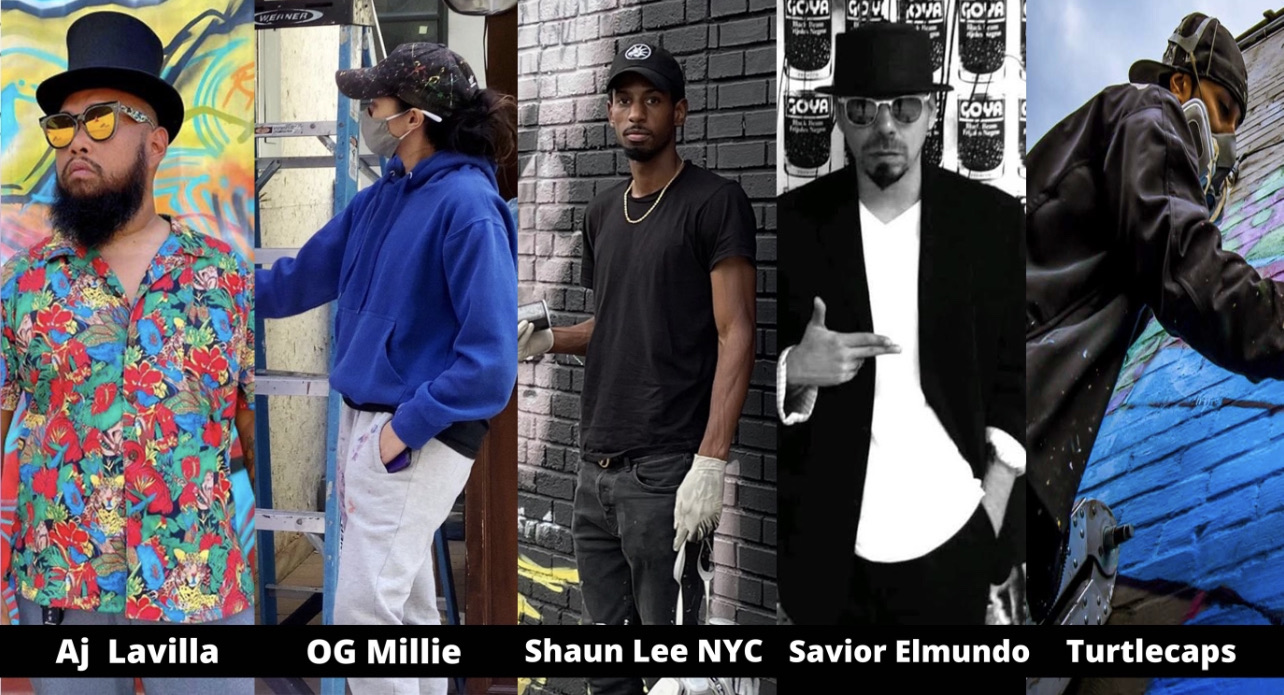Lifestyle
5 Queens, NYC Artists You Should Know

Queens is probably one of the most under-discovered places in New York. It is usually known by sports fans all over the world because of the Flushing Meadows Corona Park, home of the annual US Open tennis championship. As well as Citi Field which is another sports complex, situated in the Park. But most people are unaware that Queens is also home to many great, emerging artists.
Some of these talented artists in Queens are mentioned below:
AJ Lavilla
Born in Iloilo, Philippines, AJ Lavilla is a self-taught artist, currently based in Queens, New York. He was introduced to art at the age of eleven and learned a great deal by observing the works of his favorite artists which include Picasso, Murakami, Basquiat, and KAWS.
AJ Lavilla’s main interest is in street art and graffiti. His work is unique in the sense that he uses pop culture icons and vivid colors to bring his art to life. He is also known for the use of inspirational quotes in his work. The Queens artist has graced many walls of New York with his murals, including the World Trade Center.
OG Millie
Kamille Ejerta, known more popularly by her street name OG Millie is another Filipino American artist. The New York artist is widely known for the amazing art that she creates despite being visually impaired. Art became her safe escape after she suffered a vision-threatening emergency.
Her art can be easily identified in a sea of paintings because of its uniqueness. She uses vintage decorative mirrors as a canvas to paint portraits with acrylic paint. She is also a mural artist and her work can be seen on walls throughout New York. Her paintings are an embodiment of old school meets new school. OG Millie’s art focuses on colorful portraits of iconic figures.
Shaun Lee NYC
Shaun Lee NYC one of the most talented artists from Queens, New York. Specializing in a broad style thats unique enough to distinguish. He started developing his art career at a very young age, which prompted him to participate in many programs since a child. He has showcased work in art shows all around the world, from Paris, to Quebec, and Montreal. To residences in New York Cities night clubs such as the Freehold NY.
The Queens artist is widely known for his unique art style which includes unique shades of red in majority of his canvases. However diverse in his mediums with ability to control a spray-can like a brush. He currently has murals displayed in the heart of Queens and has plans to create many more. His artwork is popular for converting traditional art ideas into contemporary pieces.
Savior Elmundo
Savior Elmundo is a New York artist, dancer, and filmmaker. He is well known for the 3-D letter work that he started experimenting with, in 2015. Since then, the 3-D letters have become his trademark. His art icons include Dali, Picasso, Andy Warhol, Matisse, and Frida.
Elmundo loves playing with different textures and he does a lot of message work. His art can also be identified by his logo, ‘Make Art’. According to him, his logo represents all forms of art and is a simple way of reminding people to make art.
Turtlecaps
Turtlecaps is a Queens-born graffiti artist. He started practicing his art in the late 1980s by drawing on streets, train tracks, etc. True to his name, Turtlecaps, his main character is that of a turtle.
This character is made up of a turtle shell, with Mickey mouse shoes, a spray can cap for a head, and a wind-up key at the back. The Queens artist spends his time painting murals of his representative character on the streets of New York, with various adaptations.
Lifestyle
How Magic Moment Resort Became the Pioneer of a New Era: The First-Ever Dazzler Select by Wyndham

In Central Florida’s packed landscape of family hotels and theme park lodgings, a unique kind of property has emerged. Magic Moment Resort & Kids Club in Orlando is earning attention from traveling families for a simple reason. It delivers joy, warmth, and convenience at a smart value that keeps Disney dreams accessible rather than overwhelming.
By joining Wyndham, Magic Moment Resort unlocks the strength of a global powerhouse, gaining worldwide visibility, advanced technology, and access to Wyndham Rewards, the largest hotel loyalty program on the planet. This strategic move expands its reach, builds guest trust, and amplifies its impact, all while preserving the unique identity that sets it apart.
Just a short drive from the gates of Walt Disney World, the resort sits along the palm-framed stretch of West Irlo Bronson Memorial Highway. The location has long been known for its tourism bustle, yet Magic Moment has carved out a softer identity. It feels playful and colorful, but also intentional. It is designed by a family for other families, and that perspective shapes every experience on the property.
A Philosophy Rooted in Family Connection
Magic Moment Resort was built with a belief often forgotten in today’s tourism industry. Family vacations should feel uplifting instead of stressful, and affordability should not come at the expense of comfort or creativity.
Check-in feels more personal than transactional. Parents arrive with strollers, snacks, and tired children. The staff seems to understand this rhythm instinctively. The energy is warm, the pace is easy, and the tone is set long before anyone even enters the room.
Unlike competing hotels that charge a steep premium for proximity to the parks, Magic Moment focuses on smart value without compromise. Its pricing strategy is refreshingly straightforward. Families can stay five minutes from Disney without draining their travel budgets. For many guests, that difference helps shift resources from hotel costs to experiences. It means more character breakfasts, more souvenirs, and more freedom to enjoy the parks without financial tension following every decision.
Spaces Designed for Children and Considerate of Parents
Magic Moment is filled with color, but nothing feels overstimulating. Instead, the resort offers a sense of wonder scaled to a child’s imagination.
The themed family rooms are a highlight. Children step into rooms that feel lighthearted and whimsical, yet parents appreciate that they are also functional and comfortable. It is the atmosphere of a themed suite without the theme park price.
Its Kids Club and Teens Club reflect that same thoughtful balance. These spaces invite exploration and creativity for children and provide a nurturing level of supervision. Parents can enjoy an hour by the heated pool, relax in a shaded cabana, or simply take a quiet moment while knowing their children are safe and engaged.
The resort’s grounds encourage slow mornings and gentle afternoons.There’s a 30,000 sqf outdoor playground as well as peaceful corners for parents. Importantly, families are not asked to pay additional fees to enjoy them. Magic Moment’s amenities feel generous rather than transactional.
Unforgettable Days at the Parks
For families navigating a Disney vacation, convenience is often the true luxury. Magic Moment delivers this with a complimentary delicious hot breakfast that encourages everyone to sit and enjoy the start of the day rather than rush through it.
Transportation to the parks is included, which removes one of the most common stress points for visiting families. There is no parking lot maze and no long lines at the toll booths. Guests simply board the shuttle and begin their day with ease.
When the sun sets and everyone returns from a day of rides and parades, the resort becomes a place to unwind. Children head straight for the pool. Parents sip Starbucks coffee. The atmosphere is relaxed and bright, and the resort feels like an extension of the Disney experience rather than a pause from it.
A Value That Resonates with Families
What truly elevates Magic Moment is the balance it achieves between smart value and experience. The resort has cultivated a loyal following because guests feel they receive more than they pay for. More thoughtful design. More space for connection. More comfort without excess.
Affordability here does not signal minimalism. Instead, it allows families to breathe. It creates space for shared moments that are often overlooked in the rush of theme-park vacations. Children play freely. Parents unwind without guilt. Families spend more time together and less time navigating logistics.
A Resort Built with Heart
Magic Moment Resort & Kids Club stands out in a region overflowing with hospitality options. Its charm is not rooted in extravagance. It is grounded in sincerity. It reflects the belief that family travel should feel joyful, accessible, and full of color.
For families planning a Disney visit, it represents more than a place to sleep. It is a retreat where memories can form in the quiet moments as much as in the thrilling ones.
At Magic Moment, the greatest luxury is not an amenity. It is the feeling of being exactly where you are meant to be, together.
-

 Tech5 years ago
Tech5 years agoEffuel Reviews (2021) – Effuel ECO OBD2 Saves Fuel, and Reduce Gas Cost? Effuel Customer Reviews
-

 Tech6 years ago
Tech6 years agoBosch Power Tools India Launches ‘Cordless Matlab Bosch’ Campaign to Demonstrate the Power of Cordless
-

 Lifestyle6 years ago
Lifestyle6 years agoCatholic Cases App brings Church’s Moral Teachings to Androids and iPhones
-

 Lifestyle5 years ago
Lifestyle5 years agoEast Side Hype x Billionaire Boys Club. Hottest New Streetwear Releases in Utah.
-

 Tech7 years ago
Tech7 years agoCloud Buyers & Investors to Profit in the Future
-

 Lifestyle5 years ago
Lifestyle5 years agoThe Midas of Cosmetic Dermatology: Dr. Simon Ourian
-

 Health7 years ago
Health7 years agoCBDistillery Review: Is it a scam?
-

 Entertainment6 years ago
Entertainment6 years agoAvengers Endgame now Available on 123Movies for Download & Streaming for Free
